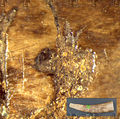SR-6
| Inscription | |
|---|---|
| Transliteration: | aṛụseθar·̣nateris·̣nạ |
| Original script: | |
| Variant Reading: | aḷụseθar·̣na teris·̣nạ |
|
| |
| Object: | SR-6 antler (antler) |
| Position: | front |
| Script: | North Italic script (Magrè alphabet) |
| Direction of writing: | sinistroverse |
| Letter height: | 1.21.2 cm <br /> – 1.7 cm |
| Number of letters: | 17 |
| Number of lines: | 1 |
| Craftsmanship: | engraved |
| Current condition: | complete, damaged |
| Date of inscription: | 3rd century BC [from object] |
| Date derived from: | archaeological context [from object] |
|
| |
| Language: | Raetic |
| Meaning: | unknown |
|
| |
| Alternative sigla: | IR 88 LIR SE-2 |
| Sources: | Schumacher 2004: 158 |
Images
|
Object SR-6 antler with inscription SR-6.
|
Inscription SR-6 - detail (miscroscopic image).
|
Inscription SR-6 - detail (microscopic image).
|
Inscription SR-6 - detail (microscopic image).
|
Commentary
First published in Pellegrini & Sebesta 1965: 13 (no. 6). Autopsied by TIR in November 2014.
Images in Pellegrini & Sebesta 1965: 13 (drawing) and fig. 8 (photo), IR (drawing = LIR), LIR (photo).
Length about 10 cm, starting at the broader end of the piece of antler. The first three characters are the most heavily damaged: ![]() seems comparatively clear; the next letter was read
seems comparatively clear; the next letter was read ![]() by Pellegrini, but might also be
by Pellegrini, but might also be ![]() (but see below).
(but see below). ![]() is fairly secure again, its right hasta being affirmed by a straight breaking edge (see drawing). After the second
is fairly secure again, its right hasta being affirmed by a straight breaking edge (see drawing). After the second ![]() ,
, ![]() , damaged in the lower area, appears to have a punctuation mark inscribed into it. The letter after the third
, damaged in the lower area, appears to have a punctuation mark inscribed into it. The letter after the third ![]() is certainly not
is certainly not ![]() , but
, but ![]() , as already seen by Mancini. A punctuation mark is very probably situated after the second
, as already seen by Mancini. A punctuation mark is very probably situated after the second ![]() , right above the breaking edge. The object being broken into multiple fragments, it has been restored, with the group of fragments on the narrow end having been attached incorrectly; the reading of
, right above the breaking edge. The object being broken into multiple fragments, it has been restored, with the group of fragments on the narrow end having been attached incorrectly; the reading of ![]() is impeded, but secure (cp. the photos and drawings provided by Pellegrini & Sebesta 1965 and Mancini). Of final
is impeded, but secure (cp. the photos and drawings provided by Pellegrini & Sebesta 1965 and Mancini). Of final ![]() , only the uppermost tip is left.
, only the uppermost tip is left.
Mancini perceives the sequences aruseθarna and terisna to be separated by a space. In any case, the final part of the inscription can be identified as the word terisna; the sequence before it may be a name, possibly a two-part name formula in the nominative aruse θar-na / arus eθar-na / aru seθar-na. Cp. SR-3.1 with possibly a name base aruś. In both parts of the inscription, the suffix -na is preceded by a punctuation mark, but it cannot be determined whether this is the intention, as the punctuation is also in line with the Venetic rules for syllable punctuation. For the inscribed punctuation mark ![]() cp. SR-1/SR-7; see Script for a discussion.
cp. SR-1/SR-7; see Script for a discussion.
Further references: Pellegrini & Sebesta 1965: 22 f., Tibiletti Bruno 1978: 234.
Bibliography
| IR | Alberto Mancini, "Iscrizioni retiche", Studi Etruschi 43 (1975), 249–306. |
|---|---|
| LIR | Alberto Mancini, Le Iscrizioni Retiche [= Quaderni del dipartimento di linguistica, Università degli studi di Firenze Studi 8–9], Padova: Unipress 2009–10. (2 volumes) |


